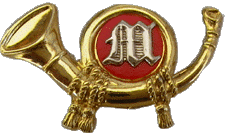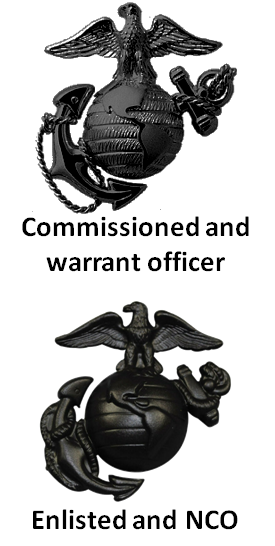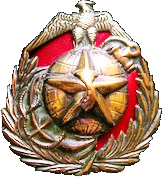Eagle, Globe, And Anchor on:
[Wikipedia]
[Google]
[Amazon]
 The Eagle, Globe, and Anchor (commonly referred to as an EGA) is the official emblem and insignia of the
The Eagle, Globe, and Anchor (commonly referred to as an EGA) is the official emblem and insignia of the
 In 1776, the device consisted of a fouled
In 1776, the device consisted of a fouled

 The emblem recommended by the 1868 board consisted of a ''globe'' (showing the continents of the
The emblem recommended by the 1868 board consisted of a ''globe'' (showing the continents of the
 In 1954, the USMC Commandant, General Lemuel C. Shepherd, Jr., requested the design of an official seal for the corps.
The new seal included the traditional Eagle, Globe, and Anchor emblem in gold, with the Globe and anchor rope in silver. The eagle is depicted with wings displayed, standing upon the western hemisphere of the terrestrial globe, and holding in his beak a white ribbon bearing the Marine Corps motto "''Semper Fidelis''" (Always Faithful) with the hemisphere superimposed on a fouled anchor. An American
In 1954, the USMC Commandant, General Lemuel C. Shepherd, Jr., requested the design of an official seal for the corps.
The new seal included the traditional Eagle, Globe, and Anchor emblem in gold, with the Globe and anchor rope in silver. The eagle is depicted with wings displayed, standing upon the western hemisphere of the terrestrial globe, and holding in his beak a white ribbon bearing the Marine Corps motto "''Semper Fidelis''" (Always Faithful) with the hemisphere superimposed on a fouled anchor. An American
 The emblem of the U.S. Marine Corps became an inspiration of the marine corps and naval infantry insignia of other nations, such as Thailand, Taiwan, and South Korea. The
The emblem of the U.S. Marine Corps became an inspiration of the marine corps and naval infantry insignia of other nations, such as Thailand, Taiwan, and South Korea. The
United States Marine Corps
The United States Marine Corps (USMC), also referred to as the United States Marines, is the maritime land force service branch of the United States Armed Forces responsible for conducting expeditionary and amphibious operations through c ...
. The current emblem traces its roots in the designs and ornaments of the early Continental Marines
The Continental Marines were the amphibious infantry of the American Colonies (and later the United States) during the American Revolutionary War. The Corps was formed by the Continental Congress on November 10, 1775 and was disbanded in 17 ...
as well as the United Kingdom
The United Kingdom of Great Britain and Northern Ireland, commonly known as the United Kingdom (UK) or Britain, is a country in Europe, off the north-western coast of the continental mainland. It comprises England, Scotland, Wales and ...
's Royal Marines
The Corps of Royal Marines (RM), also known as the Royal Marines Commandos, are the UK's special operations capable commando force, amphibious warfare, amphibious light infantry and also one of the :Fighting Arms of the Royal Navy, five fighti ...
. The present emblem, adopted in 1955, differs from the emblem of 1868 only by a change in the eagle. Before that time many devices, ornaments, ribbons, and distinguishing marks followed one another as official badges of the corps.
History
 In 1776, the device consisted of a fouled
In 1776, the device consisted of a fouled anchor
An anchor is a device, normally made of metal , used to secure a vessel to the bed of a body of water to prevent the craft from drifting due to wind or current. The word derives from Latin ''ancora'', which itself comes from the Greek � ...
(tangled in its rope) of silver
Silver is a chemical element with the symbol Ag (from the Latin ', derived from the Proto-Indo-European ''h₂erǵ'': "shiny" or "white") and atomic number 47. A soft, white, lustrous transition metal, it exhibits the highest electrical ...
or pewter
Pewter () is a malleable metal alloy consisting of tin (85–99%), antimony (approximately 5–10%), copper (2%), bismuth, and sometimes silver. Copper and antimony (and in antiquity lead) act as hardeners, but lead may be used in lower grades ...
. Changes were made in 1798, 1821, and 1824. In 1834, it was prescribed that a brass
Brass is an alloy of copper (Cu) and zinc (Zn), in proportions which can be varied to achieve different mechanical, electrical, and chemical properties. It is a substitutional alloy: atoms of the two constituents may replace each other wi ...
eagle be worn on the cover, the eagle to measure from wingtip to wingtip. An eagle clutching a fouled anchor with thirteen six-pointed stars
A star is an astronomical object comprising a luminous spheroid of plasma held together by its gravity. The nearest star to Earth is the Sun. Many other stars are visible to the naked eye at night, but their immense distances from Earth ma ...
above was used on uniform buttons starting in 1804. This same insignia is used today on the buttons of Marine dress and service uniforms, with the six-pointed stars changed to five-pointed stars.
During the early years numerous distinguishing marks were prescribed, including "black cockades", "scarlet plumes", and "yellow bands and tassels". In 1859, the first version of the present color scheme for the officer's dress uniform insignia appeared on an elaborate device of solid white metal and yellow metal. The design included a United States shield, half wreath, a bugle
The bugle is one of the simplest brass instruments, normally having no valves or other pitch-altering devices. All pitch control is done by varying the player's embouchure.
History
The bugle developed from early musical or communication ...
, and the letter "M."
In 1868, the USMC's commandant
Commandant ( or ) is a title often given to the officer in charge of a military (or other uniformed service) training establishment or academy. This usage is common in English-speaking nations. In some countries it may be a military or police ran ...
, Brigadier General Jacob Zeilin
Jacob Zeilin (July 16, 1806 – November 18, 1880) was the United States Marine Corps' first non- brevet flag officer. He served as the seventh commandant of the United States Marine Corps, from 1864 to 1876.
Early life and education
Zeilin was ...
, appointed a board "to decide and report upon the various devices of cap ornaments of the Marine Corps." On November 13, 1868, the board recommended the modern insignia. It was approved by the commandant four days later, and by the Secretary of the Navy
The secretary of the Navy (or SECNAV) is a statutory officer () and the head (chief executive officer) of the Department of the Navy, a military department (component organization) within the United States Department of Defense.
By law, the se ...
on November 19, 1868.
Design and symbolism

 The emblem recommended by the 1868 board consisted of a ''globe'' (showing the continents of the
The emblem recommended by the 1868 board consisted of a ''globe'' (showing the continents of the Western Hemisphere
The Western Hemisphere is the half of the planet Earth that lies west of the prime meridian (which crosses Greenwich, London, United Kingdom) and east of the antimeridian. The other half is called the Eastern Hemisphere. Politically, the te ...
) intersected by a ''fouled anchor'', and surmounted by a ''spread eagle''. On the emblem itself, there is a ribbon, clasped in the eagle's beak, bearing the Latin
Latin (, or , ) is a classical language belonging to the Italic languages, Italic branch of the Indo-European languages. Latin was originally a dialect spoken in the lower Tiber area (then known as Latium) around present-day Rome, but through ...
motto "''Semper Fidelis
''Semper fidelis'' () is a Latin phrase that means "always faithful" or "always loyal" (Fidelis or Fidelity). It is the motto of the United States Marine Corps, usually shortened to Semper Fi. It is also in use as a motto for towns, families, ...
''" ( en, Always Faithful). The uniform insignias omit the motto ribbon.
The general design of the emblem was probably derived from the Royal Marines' "Globe and Laurel." The globe on the U.S. Marine emblem signifies the Corps' readiness to service in any part of the world. The eagle represents the United States. The anchor, which dates back to the founding of the corps in 1775, acknowledges the naval tradition of the Marines and their continual service within the Department of the Navy.
There are some differences between the uniform insignia for enlisted marines and that of officers:
The enlisted Marines' dress blue uniform insignia is die-struck from a single sheet of brass and anodized a gold color. The service uniform insignia is coated a flat black color.
The officers' insignia is assembled from four parts: a die-struck silver colored globe with eagle, and gold colored anchor with silver colored fouling rope, and gold colored continents.
Current emblem and seal
bald eagle
The bald eagle (''Haliaeetus leucocephalus'') is a bird of prey found in North America. A sea eagle, it has two known subspecies and forms a species pair with the white-tailed eagle (''Haliaeetus albicilla''), which occupies the same niche as ...
replaced the crested eagle
The crested eagle (''Morphnus guianensis'') is a large Neotropical eagle. It is the only member of the genus ''Morphnus''. The crested eagle can grow up to long, with a wingspan up to , and weigh up to . The plumage varies between a light br ...
depicted on the 1868 emblem.
The emblem is displayed on a scarlet background encircled with a blue band bearing the phrases "Department of the Navy" above and "United States Marine Corps" below in white letters, the whole edged in a gold rope
U.S. President Eisenhower approved the design on June 22, 1954. The emblem as shown on the seal was adopted in 1955 as the official Marine Corps emblem.
Similar symbols
 The emblem of the U.S. Marine Corps became an inspiration of the marine corps and naval infantry insignia of other nations, such as Thailand, Taiwan, and South Korea. The
The emblem of the U.S. Marine Corps became an inspiration of the marine corps and naval infantry insignia of other nations, such as Thailand, Taiwan, and South Korea. The Republic of Korea Marine Corps
The Republic of Korea Marine Corps (ROKMC; ko, 대한민국 해병대, Daehanminguk Haebyeongdae), also known as the ROK Marine Corps or ROK Marines, is the marine corps of South Korea. The ROKMC is a branch of the Republic of Korea Navy respo ...
(ROKMC), the Royal Thai Marine Corps
The Royal Thai Marine Corps or RTMC ( th, ราชนาวิกโยธินแห่งราชอาณาจักรไทย) are the marines of the Royal Thai Navy. The Royal Thai Marine Corps was founded in 1932, when the first batt ...
(RTMC), and the Republic of China Marine Corps
The Republic of China Marine Corps (ROCMC; ), also known colloquially as the Taiwan Marine Corps, is the amphibious arm of the Republic of China Navy (ROCN) responsible for amphibious combat, counter-landing and reinforcement of the areas under th ...
(ROCMC) use an insignia that bears a resemblance to the emblem of the USMC.
The emblem of the South Korean marines consists of a golden star superimposed into the fouled anchor. The eagle is similar to that of the USMC's.
The insignia of the Thai marines is similar to that of the USMC, with the exception of a golden Garuda
Garuda ( Sanskrit: ; Pāli: ; Vedic Sanskrit: गरुळ Garuḷa) is a Hindu demigod and divine creature mentioned in the Hindu, Buddhist and Jain faiths. He is primarily depicted as the mount (''vahana'') of the Hindu god Vishnu. Garu ...
above the globe, and a silhouette map of Thailand.
The emblem of the Taiwanese marines is similar to that of the USMC, with the exception of a Blue Sky with a White Sun
The Blue Sky with a White Sun () serves as the design for the party flag and emblem of the Kuomintang, the canton of the flag of the Republic of China, the national emblem of the Republic of China, and as the naval jack of the ROC Navy.
In th ...
above the globe, and a silhouette map of the Republic of China's claimed territories, including Mainland China
"Mainland China" is a geopolitical term defined as the territory governed by the China, People's Republic of China (including islands like Hainan or Chongming Island, Chongming), excluding dependent territories of the PRC, and other territorie ...
and Outer Mongolia
Outer Mongolia was the name of a territory in the Manchu people, Manchu-led Qing dynasty of China from 1691 to 1911. It corresponds to the modern-day independent state of Mongolia and the Russian republic of Tuva. The historical region gain ...
.
The Republic of Vietnam Marine Division
The Republic of Vietnam Marine Division (RVNMD, vi, Sư Đoàn Thủy Quân Lục Chiến QLC was part of the armed forces of South Vietnam. It was established by Ngo Dinh Diem in 1954 when he was Prime Minister of the State of Vietnam, which be ...
, a.k.a. the South Vietnamese Marine Corps (VNMC), also used an emblem similar to that of the USMC, with the exception of a map of Vietnam and a red star superimposed onto the globe.
See also
*Fleet Marine Force Combat Operation Insignia
The Fleet Marine Force Combat Operation Insignia is a miniature inch bronze United States Marine Corps emblem that may be authorized by the Secretary of the Navy for wear on specific campaign, expeditionary, and service medal ribbons issued to U ...
* Flag of the United States Marine Corps
* History of the United States Marine Corps
*Prop and Wings
A prop, formally known as (theatrical) property, is an object used on stage or screen by actors during a performance or screen production. In practical terms, a prop is considered to be anything movable or portable on a stage or a set, distinc ...
* Space Force Delta
* Henry Clay Cochrane
References
Further reading
*External links
* * {{DEFAULTSORT:Eagle, Globe, And Anchor United States Marine Corps lore and symbols Seals of organizations Heraldry of the United States military Military symbols Heraldic charges Birds in art Maps in art